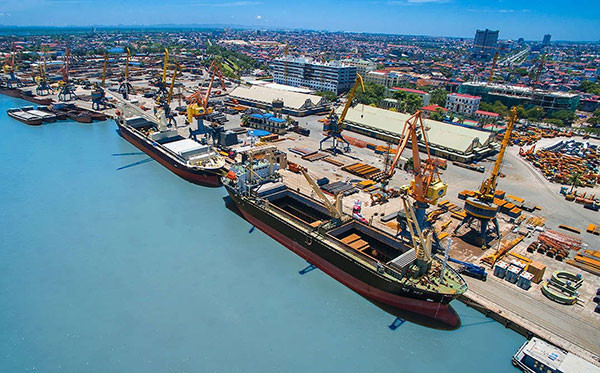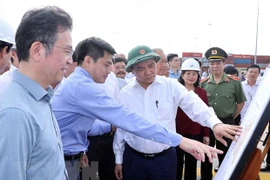 Tran De seaport in Soc Trang province. The Government plans to develop the port into a national deep-water seaport to improve transportation in the Mekong Delta (Photo: baocantho.com.vn)
Tran De seaport in Soc Trang province. The Government plans to develop the port into a national deep-water seaport to improve transportation in the Mekong Delta (Photo: baocantho.com.vn)The Trung Luong - My ThuanExpressway, for example, is expected to significantly speed up product deliveryonce it opens for traffic this year.
The Ministry of Transport plansto build another expressway between Can Tho city and Ca Mau province.
In the last five years,highways and bridges have been upgraded as have navigation channels in the Hauriver, while the Cho Gao Canal in Tien Giang province has been dredged.
Lam said: “Poor transportinfrastructure is a major obstacle for the Mekong Delta. Implementation of keyprojects by the Government is still slow.”
The Government has approved anallocation of 2.5 billion USD for infrastructure development over the next fiveyears.
Annually the delta exports17-18 million tonnes of goods, but 70 percent has to be shipped from majorports in Ho Chi Minh City and Ba Ria - Vung Tau province, which increasestransportation costs by 10-40 percent.
“It costs 5 million VND (216.6USD) to transport 10 tonnes of catfish from our company in Can Tho city to HCMCity. If we could use Cai Cui seaport in Can Tho city instead, it will costonly 1.5 million VND (65 USD),” Tran Van Quang, Chairman of Southern FisheryIndustries Co Ltd, said.
The Cai Cui Port was built tohandle vessels of 20,000 tonnes, but now only those of up to 7,000 tonnes canenter it due to the difficult access through small canals.
Investment in transportinfrastructure would help the delta cut logistics costs.
An official from Ca Mauprovince’s transport department called for prioritising investment in inlandwaterways that are connected with roads to improve transportation throughoutthe delta and exploit the waterway system linking HCM City with other provincesand cities.
Next month the ministry willseek approval from the Government to build the Tran De deep-water port in SocTrang Province capable of receiving vessels of up to 100,000 tonnes.
The port, not to be funded bypublic funds, is expected to achieve a throughput capacity of 50-55 milliontonnes by 2030.
Setting up logistics centres
According to the VietnamChamber of Commerce and Industry (VCCI) and the Fulbright School of PublicPolicy and Management, logistics activities in Mekong Delta remain largelyunplanned.
More than 85 percent of itsports are scattered with each having a capacity of handling less than 10,000tonnes of cargo annually.
The region also lacks asynchronised transport system, logistics centres, warehouses, and containeryards, and companies have to send their products to HCM City for sterilisingand irradiating, all of which increase logistics expenses.
Le Duy Hiep, Chairman of the VietnamLogistics Business Association, said the delta is the country’s agriculturalexport hub but logistics costs are 20-25 percent compared to 10-15 percent inneighbouring countries.
Besides, for a long time, Deltalocalities have only focused on stages between the field and factory, but paidlittle attention to transporting them to ports, shipping, packaging, andinspection despite their decisive role in the competitiveness of agriculturalproducts.
"That is the reason why itis very important to develop logistics centres capable of handling all stagesof agricultural production," Lam said.
“This would reduce the waitingtimes and cumbersome procedures.”
Ho Thi Thu Hoa, head of the VietnamLogistics Research and Development Institute, said a national plan fordeveloping logistics by 2015 had included two second-level logistic centres inthe region, but they remain on paper.
Recently the first phase of theHanh Nguyen Logistics Centre, a self-contained logistics hubfor agricultural exports, began operation in Hau Giang province. The province targets having five such centres by2025.
The opening of a logisticscentre will help connect all stages in the agricultural supply chain./.





























